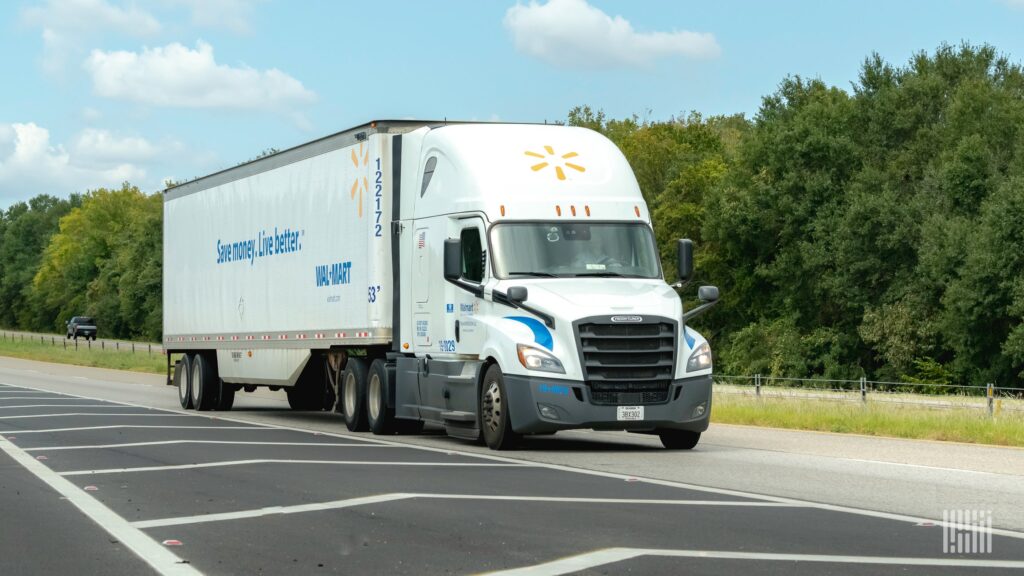A Walmart truck driver from Texas, who prefers to remain anonymous due to company policy, stated he has 15 years of work left and plans to spend that time driving for Walmart. He remarked, “Unless I win the lottery or marry someone wealthy, I don’t envision leaving.” This level of commitment to one employer is rare in the trucking industry, which is known for its high turnover rates. Walmart attracts such loyalty because it offers competitive pay; drivers can earn up to $110,000 in their first year, significantly higher than the national average for truck drivers and the typical pay for Walmart associates, which is around $17.50 per hour. In addition to good pay, Walmart provides predictable home time, paid vacations, and comprehensive health insurance—benefits that are hard to come by in the trucking sector.
Walmart’s generous compensation isn’t merely a charitable gesture; it recognizes the crucial role drivers play in maintaining its retail supremacy. The company has relied on a committed trucking workforce since its inception, ensuring rapid delivery and distribution—a hallmark of its business model. A Walmart spokesperson emphasized the company’s goal of offering an attractive compensation package to recruit top-tier drivers in the industry.
Currently, Walmart employs about 14,000 drivers, making it comparable to some of the largest for-hire fleets in the United States, having recruited 5,800 new drivers over the last five years. However, the company’s approach to recruiting has evolved. In 2018, Walmart revised its driver hiring program, aiming to facilitate more applicants due to a perceived driver shortage. Critics of this concept argue that the real issue is that drivers leave for more appealing opportunities rather than an actual lack of available labor.
Walmart’s Rise Through Strategic Distribution
Historically, Walmart faced challenges in distributing goods to remote areas where it established its stores. Early executives recalled difficulties in finding trucking companies willing to deliver to these locations, prompting the retail giant to build its own distribution system. Founder Sam Walton’s vision led Walmart to work directly with brands, enabling greater control over its supply chain and logistics—an essential strategy for its success as the largest retailer globally.
Walmart’s meticulous approach to distribution is evident in how it plans new store openings. Instead of simply establishing stores in populous areas, it prioritizes building distribution centers first. This innovative strategy marked a departure from competitors like Kmart and showcased Walmart’s commitment to logistical efficiency as a way to gain a competitive advantage.
Walmart’s Unique Focus on Trucking
Others in the retail sector, such as Kroger and Home Depot, also have extensive supply chains yet don’t emphasize trucking operations to the same extent as Walmart. Experts attribute this to Walmart’s sheer size and operational complexity, as well as its significant private trucking fleet, which gives it leverage over equipment manufacturers. The company’s spokesperson stated that managing its own distribution allows for better customer service and cost control.
Having reliable supply logistics is fundamental for retail success. If products aren’t available when customers shop, it undermines their experience and could lead to dwindling sales. For Walmart, investing in its truck drivers is not just an expense but a strategic decision foundational to its operations, influencing the shopping experiences of millions.
Walmart is adapting its truck driver hiring policies by introducing an Associate-to-Driver program, allowing current associates the opportunity to transition to trucking positions after a 12-week training course, in a shift from past requirements that mandated 30 months of driving experience. This program aims to promote career growth among its associates, aligning with Walmart’s philosophy of valuing internal talent.
The Ongoing Debate Over Driver Shortages and Training Initiatives
Some Walmart drivers have expressed concerns regarding these policy changes. One driver suggested that raising pay could enhance retention and attract seasoned drivers, while another worried that Walmart might start to resemble for-hire fleets, with high turnover rates. The debate around a driver shortage continues, with some experts and drivers connecting the high turnover to factors like working conditions rather than an actual scarcity of drivers. Walmart’s recent hiring drive, bringing in nearly 6,000 drivers, highlights its need for a stable workforce as it expands operations.
Experts believe the Associate-to-Driver initiative is not merely a cost-cutting measure but a strategic maneuver aimed at maintaining control over training standards and corporate culture. By training internal candidates, Walmart reduces the risk of ingraining undesirable habits typically found in drivers from other companies, promoting a workforce that aligns closely with its operational goals and customer service standards.


